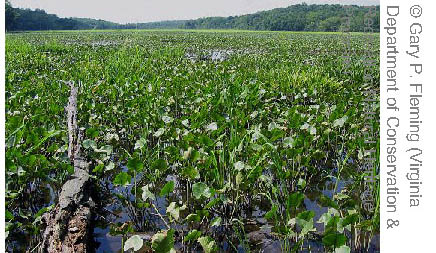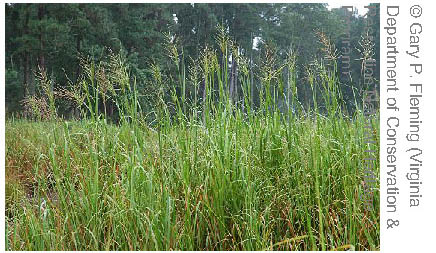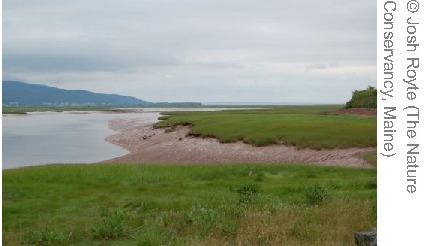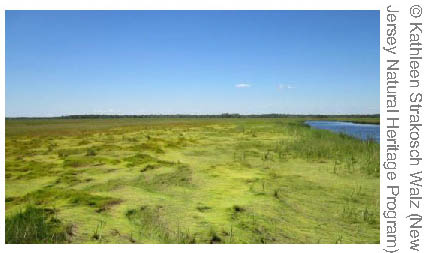The Tidal marsh macrogroup consists of the following habitats:
Atlantic Coastal Plain Embayed Region Tidal Freshwater/Brackish Marsh


Regional distribution:
VA. 13,051 total acres of habitat, of which 69.1% is conserved.
Description:
A emergent marsh of the embayed region of southeastern Virginia and adjacent North Carolina. The water is fresh to slightly brackish (oligohaline) over most of the tidal areas, with brackish and saltwater only near the coast and near barrier island inlets. Oligohaline marshes, predominant in the drowned creeks and inland estuary shores, typically occur as complexes dominated by large graminoids such as salt hay, bulrushes, cattails, and rushes, sometimes with species-rich associations of shorter graminoids, forbs, and floating or submerged aquatics. Brackish marshes tend to be low diversity, sometimes a single plant species, found on intertidal flats cut off from direct oceanic influence by protective barrier islands. Embedded within the matrix of marshes are smaller salt pannes.
Download the
pdf for this habitat for information about species, crosswalks to state names, and condition of this habitat.
North Atlantic Coastal Plain Brackish/Fresh & Oligohaline Tidal Marsh


Regional distribution:
VA. 17,021 total acres of habitat, of which 14.6% is conserved.
Description:
A graminoid-dominated wetland of fresh to slightly brackish zones along tidal rivers in very southeast Virginia and the southern shores of the James River. Water salinity varies from nearly fresh (oligohaline) in the drowned creeks and inland estuaries to saltier brackish water near the coast and on or near barrier island inlets. These marshes typically occur as complexes dominated by large graminoids such as salt hay, bulrushes, cattails, and rushes, sometimes with species-rich associations of shorter graminoids, forbs, and floating or submerged aquatics. Brackish marshes tend to be low diversity communities of intertidal flats cut off from direct oceanic influence by protective barrier islands.
Download the
pdf for this habitat for information about species, crosswalks to state names, and condition of this habitat.
Acadian Coastal Salt and Estuary Marsh


Regional distribution:
ME. 30,065 total acres of habitat, of which 23.8% is conserved.
Description:
A saltwater and brackish marsh that occurs along the immediate ocean shore and estuary mouths of the Gulf of Maine. Sometimes called "salt meadows," these marshes display strong graminoid dominance, with patchy forbs. Salt hay and smooth cordgrass are the major dominants. For the purposes of mapping, these include the uncommon salt ponds sometimes found behind barrier beaches, and the marshes found along brackish estuaries of the Gulf of Maine. In brackish occurrences, dominance ranges from extensive bulrush beds and tall grasses and sedges to sparsely vegetated mudflat. Where the coastal topography becomes more dissected, they are commonly seen as a fairly narrow fringe along tidal shorelines.
Download the
pdf for this habitat for information about species, crosswalks to state names, and condition of this habitat.
North Atlantic Coastal Plain Tidal Salt Marsh


Regional distribution:
CT, DC, DE, MA, MD, ME, NH, NJ, NY, PA, RI, VA. 920,107 total acres of habitat, of which 45.2% is conserved.
Description:
A complex of tidally influenced marshes from the coastal shore on up the tidal rivers of the Northern Atlantic Coastal Plain. This habitat includes salt marsh, brackish marsh, and freshwater tidal marsh. A salt marsh profile features a low regularly flooded marsh dominated by salt marsh cordgrass; a higher irregularly flooded marsh dominated by saltmeadow cordgrass and saltgrass; low hypersaline pannes characterized by saltwort; and a salt scrub ecotone characterized by marsh elder, groundsel-tree, and switchgrass. Brackish areas support salt marsh cordgrass, giant cordgrass, narrowleaf cattail, and bulrush. Freshwater tidal areas include wild rice marshes, and forbs such as water hemp, and rosemallow.
Download the
pdf for this habitat for information about species, crosswalks to state names, and condition of this habitat.